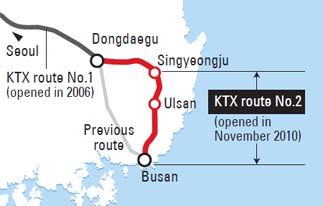The switch boxes that don’t switch

Several track-switching boxes installed last year on a high-speed train line in Korea were found recently to have malfunctioned. [JoongAng Ilbo]
The Korea Rail Network Authority said Wednesday that 406 errors have been found in the 46 track-switching boxes along one KTX high-speed train line in the past seven months, taking concern about the safety of the nation’s train operations to a new level.
A track-switching box allows trains to switch tracks instead of continuing straight ahead. If a train fails to switch tracks, a serious accident can occur, like the KTX-Sancheon train derailment in February.
In that case, a tiny nut bolt had not been installed properly during an inspection of the switch box, which caused the track alignment to be off. There were no injuries in that accident.
The problem is so serious that the Korea Railroad Co. has said that the switch boxes can’t be used until the problem is fixed.
The switch boxes, imported from Austria and costing 11.5 billion won ($11 million), were installed on a new KTX route that opened in November between Dongdaegu and Busan.

Korea Railroad Co., which runs the KTX trains, turned off all of the switch boxes on June 2 due to the malfunction and all trains running on the route are not being allowed to switch tracks, which has led to all trains on the line being delayed by at least four minutes.
High-speed trains switch tracks to bypass local stations, allowing them to continue on at a high rate of speed.
For the past two weeks, the rail authority has been inspecting the boxes but it still hasn’t determined whether the boxes themselves are the cause of the problem or whether maintenance workers are not following proper maintenance procedures, said Jang Seok-geun, an official at the authority.
Some authority officials have been especially critical, saying that the Austrian boxes were not fully tested before being installed on the line in Korea, implying the design of the box caused the errors. “When we [chose] the boxes, experts raised questions about their safety,” an official at the authority said, “because of their lack of being tested on high-speed trains.”
A Korea Railroad official echoed that belief. “Adopting [inadequately tested] products caused the errors.” The railroad found, in fact, that the problem occurred at an alarmingly high frequency. “We found 1.9 errors have occurred every day on average since the boxes were operational,” the official said.
Experts say the boxes should have been tested on real tracks before being sold, to prove their safety and quality.
Jang, of the railroad authority, said, however, that the boxes were approved by the German Federal Railway Authority.
The Korean authority said the Austrian boxes started causing errors right after they were installed on the new route. From November to this March, the boxes registered 111 errors. Seven maintenance workers were assigned to figure out the problem but they failed to determine the reason. The number of errors increased significantly in April and May, with nearly 300 errors reported.
“After reviewing the joint investigation of the authority and other experts, we will determine whether we will repair them or install new ones,” a Ministry of Land and Maritime Affairs official told the JoongAng Ilbo.
But Bae Jun-ho, head of an association of citizens using high-speed trains, expressed his concern over the situation.
“Although it would cost some money, changing all malfunctioning boxes is required to guarantee safety of operation of trains,” he said.
By Chang Chung-hoon [heejin@joongang.co.kr]
한글 관련 기사 [중앙일보]
일반철도용 선로전환기, KTX 고속철도에 깔았다
406건 장애 원인으로 지목
정부, 2단계 구간 전수 검사
다 뜯어낼 경우 115억 날려
열차의 궤도를 바꿔주는 선로전환기가 설치된 모습. 이 설비가 고장 나면 열차 탈선 사고가 날 수도 있다.
KTX 2단계 구간(동대구역~부산역)에 설치한 선로전환기는 시속 300㎞ 이상에서는 한 번도 사용된 적이 없는 제품인 것으로 밝혀졌다. 이에 따라 한국철도시설공단이 안전성이 검증되지 않은 핵심 안전 장비를 도입해 사용 중단이라는 초유의 사태를 불러왔다는 지적이 일고 있다. <본지 6월 8일자 22면>
철도시설공단 관계자는 8일 “이번에 문제가 된 선로전환기는 도입 당시부터 안전성 논란이 있었다”며 “시속 250㎞ 이하 일반철도에 사용됐을 뿐 KTX처럼 시속 300㎞가 넘는 고속 구간 운영 실적은 전혀 없었기 때문”이라고 말했다. 철도시설공단은 선로와 신호시스템 같은 고속철도 시설을 건설하는 역할을 한다. 이후 코레일은 공단으로부터 이 시설을 넘겨받아 열차를 투입해 운영하고 유지·보수하는 업무를 담당한다. 코레일 측도 “KTX 2단계 구간에서는 개통 직후부터 선로전환기 장애가 하루에 1.9건씩 발생했다”며 “검증되지 않은 제품을 무리하게 들여온 결과”라고 지적했다.
철도 선진국의 경우 상업운행 실적이 없어 안전성이 입증되지 않은 제품은 사용하지 않는 것이 원칙이다. 이에 대해 철도시설공단 장석근 신호제어처장은 “KTX 2단계 구간의 선로전환기는 독일 연방철도국(EBA)의 안전성 인증을 거친 제품”이라며 “콘크리트로 시공한 2단계 구간의 궤도에 알맞은 제품을 선정한 것”이라고 말했다.
KTX 2단계 구간인 동대구역~부산역에 설치된 선로전환기는 모두 46대로 시공비만 115억원에 달했다. 모두 오스트리아VAEE가 제작한 하이드로스타(Hydrostar)란 기종이다. 삼성SDS가 수입해 납품했다. KTX 1단계 구간에는 프랑스산(MJ81)을 설치했다. 1단계 구간은 궤도가 자갈이어서 이에 적합한 프랑스산을 썼다.
하이드로스타는 KTX 2단계 구간이 개통된 지난해 11월부터 문제를 일으켰다. 11월 개통 당시부터 장애가 발생하기 시작해 3월까지만 111건의 오작동이 일어났다. 철도시설공단은 지난달 하순부터 제작사 기술자 7명을 불러들여 철도기술연구원 등과 합동점검을 벌였다. 하지만 선로전환기의 장애 원인을 밝혀내지 못했고 지난달 말까지 장애 건수는 오히려 406건으로 늘었다. 철도시설공단 장석근 신호제어처장은 “보름이 넘게 정밀 점검했지만 제품의 하자인지 시공상의 문제인지 밝혀내지 못했다”고 말했다.
국토해양부는 KTX 2단계 구간의 선로전환기를 7월 말까지 전수 검사한 뒤 부분적인 보수를 할지 전면 재시공할지 결정하겠다는 입장이다. 하지만 고속철도시민의 모임 배준호(한신대 교수) 대표는 “선로전환기의 오작동은 탈선 등 대형 참사를 불러올 수 있다”며 “돈이 들더라도 운행안전 확보를 위해 문제가 된 선로전환기를 교체하는 것이 바람직하다”고 말했다.
◆선로전환기=열차의 궤도를 바꿔주는 핵심 설비로 고장이 나면 탈선은 물론 전복 사고까지 불러올 수 있다. KTX가 개통한 지 7년 만의 첫 탈선사고로 기록된 지난 2월 광명역의 탈선사고도 선로전환기의 오작동이 원인이었다.










with the Korea JoongAng Daily
To write comments, please log in to one of the accounts.
Standards Board Policy (0/250자)